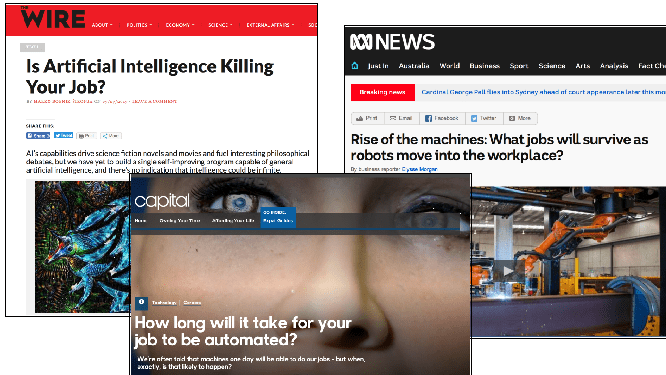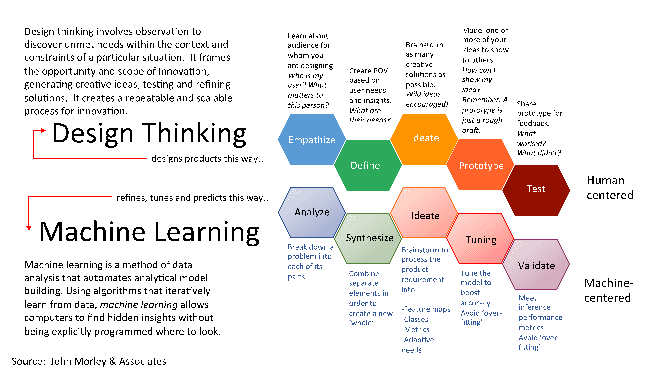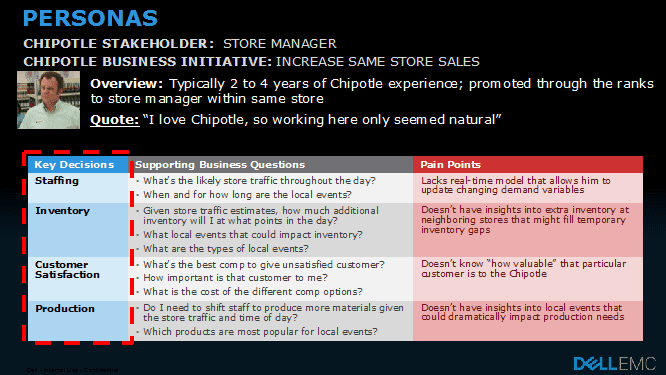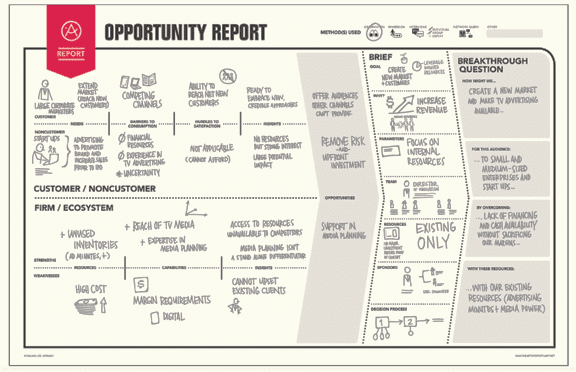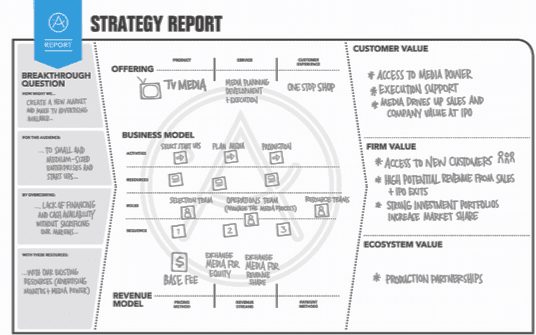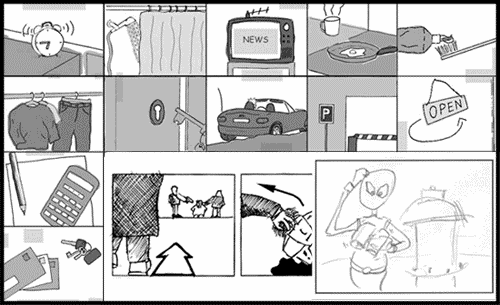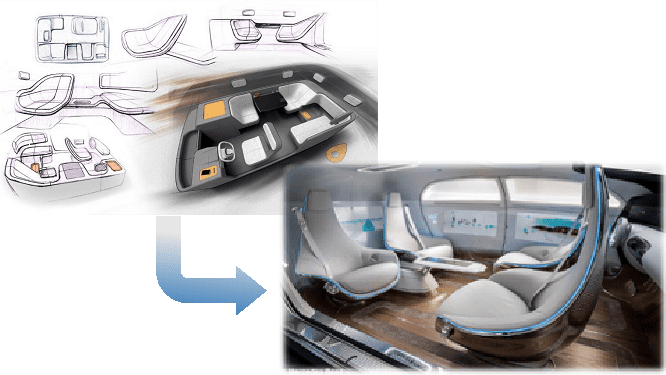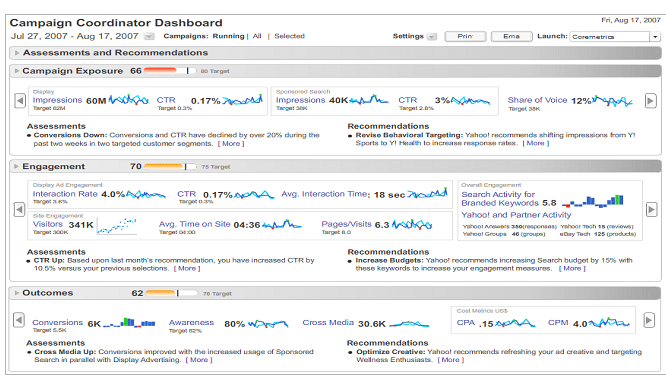It’s all over for us humans. It may not have been “The Matrix”[1], but the machines look like they are finally poised to take our jobs. Machines powered by artificial intelligence and machine learning process data faster, aren’t hindered by stupid human biases, don’t waste time with gossip on social media and don’t demand raises or more days off.
While there is a high probability that machine learning and artificial intelligence will play an important role in whatever job you hold in the future, there is one way to “future-proof” your career…embrace the power of design thinking.
I have written about design thinking before , but I want to use this blog to provide more specifics about what it is about design thinking that can help you to harness the power of machine learning…instead of machine learning (and The Matrix) harnessing you.
The Power of Design Thinking
Design thinking is defined as human-centric design that builds upon the deep understanding of our users (e.g., their tendencies, propensities, inclinations, behaviors) to generate ideas, build prototypes, share what you’ve made, embrace the art of failure (i.e., fail fast but learn faster) and eventually put your innovative solution out into the world. And fortunately for us humans (who really excel at human-centric things), there is a tight correlation between the design thinking and the machine learning (see Figure 2).
In fact, integrating design thinking and machine learning can give you “super powers” that future-proof whatever career you decide to pursue. To meld these two disciplines together, one must:
- Understand where and how machine learning can impact your business initiatives. While you won’t need to write machine learning algorithms (though I wouldn’t be surprised given the progress in “Tableau-izing” machine learning), business leaders do need to learn how to “Think like a data scientist” in order understand how machine learning can optimize key operational processes, reduce security and regulatory risks, uncover new monetization opportunities. .
- Understand how design thinking techniques, concepts and tools can create a more compelling and emphatic user experience with a “delightful” user engagement through superior insights into your customers’ usage objectives, operating environment and impediments to success.
Let’s jump into the specifics about what business leaders need to know about integrating design thinking and machine learning in order to provide lifetime job security (my career adviser bill will be in the mail)!
Step 1: Empathize and Analyze
The objective of the “Emphasize and Analyze” step is to really, and I mean really, understand your users, and to build a sense of empathy for the challenges and constraints that get in their way: Who is my user? What matters to this person? What are they trying to accomplish? What are their impediments to success? What frustrates them today? This step captures what the user is trying to accomplish (i.e., tasks, roles, responsibilities and expectations) versus what they are doing. Walk in your users’ shoes by shadowing them, and where possible, actually become a user of the product or service.
A useful tool for “Emphasize and Analyze” step is the Persona. A Persona is a template for capturing key user operational and usage requirements including the job to be done, barriers to consumption and hurdles to user satisfaction (see Figure 3).
The Persona template in Figure 3 is one that we use in our Vision Workshop engagements to capture the decisions that the key business stakeholders are trying to make – and the associated pain points – in support of the organization’s key business initiatives.
How does the “Emphasize and Analyze” step apply to Design Thinking and Machine Learning?
- Design Thinking – understand and capture the user’s task objectives, operational requirements and impediments to success; learn as much as possible about the users for whom you are designing.
- Machine Learning – Capture and prioritize the user’s key decisions; capture the variables and metrics that might be better predictors of those decisions.
Step 2: Define and Synthesize
The “Define and Synthesize” step starts to assemble an initial Point of View (POV) regarding the user’s needs: What capabilities are the user going to need? In what type of environment will the user be working? What is likely to impede the execution of their job? What is likely to hinder adoption?
Sharing your POV and getting feedback from key constituencies is critical to ensuring that you have properly defined and synthesized the requirements and potential impediments. Use the Opportunity Report to document the story, gather feedback and input from your constituencies, and refine your thinking regarding the solution (see Figure 4).
How does the “Define and Synthesize” step apply to Design Thinking and Machine Learning?
- Design Thinking – define, document and validate your understanding of the user’s task objectives, operational requirements and potential impediments. Don’t be afraid of being wrong.
- Machine Learning – synthesize your understanding of the decisions (e.g., latency, granularity, frequency, governance, sequencing) in order to flesh out the potential variables and metrics, and assess potential analytic algorithms and approaches.
Step 3: Ideate and uh… Ideate
The “Ideate and Ideate” step is all about… ideate! This is a chance to gather all impacted parties, stakeholders and other key constituents and leverage facilitation techniques to brainstorm as many creative solutions to the users’ needs and impediments as possible. Exploit group brainstorming techniques to ideate, validate and prioritize the usage and operational requirements, document those requirements in a Strategy Report and identify supporting operational and performance metrics (see Figure 5).
It is useful to make use of storyboards to refine your thinking in Step 3. A storyboard is a graphic rendition and sequencing of the usage of the solution in the form of illustrations displayed as a story (see Figure 6).
Storyboards are an effective and efficient way to communicate a potential experience and approach for your users to review and provide feedback with the help of website feedback button. Storyboarding can provide invaluable insights into usage behaviors and potential impediments without writing any code (said as if coding is something evil)!
While it would be nice to be an accomplished sketcher, even rough sketches can be an invaluable – and fast – way to gather feedback on the user experience and product design (see Figure 7).
How does the “Ideate and Ideate” step apply to Design Thinking and Machine Learning?
- Design Thinking – brainstorm as many potential solutions as possible. Diverge in your brainstorming (“all ideas are worthy of consideration”) before you converge (priority those best ideas based upon potential business and customer value and implementation feasibility).
- Machine Learning – start piloting potential analytic models and algorithms with small sample data sets to see what types of insights and relationships are buried in the data. Capture and refine the hypotheses that you want to test.
Step 4: Prototype and Tune
The “Prototype and Tune” step starts to build the product and supporting analytics. Start to model your ideas so that you can validate usage and navigational effectiveness and identify the metrics against which usage and navigational effectiveness will be measured. Wireframe and mockups are useful tools that can be used to validate product usage and navigation effectiveness (see Figure 8).
How does the “Prototype and Tune” step apply to Design Thinking and Machine Learning?
- Design Thinking – create one or more interactive mockups with which your key constituents can “play”. Study users’ interactions with the mockups to see what works and where they struggle. Identify what additional design guides and/or analytics insights could be provided to improve the user experience.
- Machine Learning – Identify where analytic insights or recommendations are needed – and what additional data can be captured – as the users “play” with the mockups. Explore opportunities to delivery real-time actionable insights to help “guide” the user experience. Fail fast, but learn faster! Embrace the “Art of Failure.”
Step 5: Test and Validate
The “Test and Validate” step seeks to operationalize both the design and analytics. But step 5 is also the start of the continuous improvement process from the user experience and analytic model tuning perspectives. Instrumenting or tagging the product or solution becomes critical so that one can constantly monitor its usage: What features get used the most? What paths are the most common? Are there usage patterns that indicate that users are confused? Are their usage paths from which users “eject” and never return?
Step 5 is also where product usage and decision effectiveness metrics can be used to monitor and ultimately improve the user experience. Web Analytics packages (like Google Analytics in Figure 9) provide an excellent example of the type of metrics that one could capture in order to monitor the usage of the product or solution.
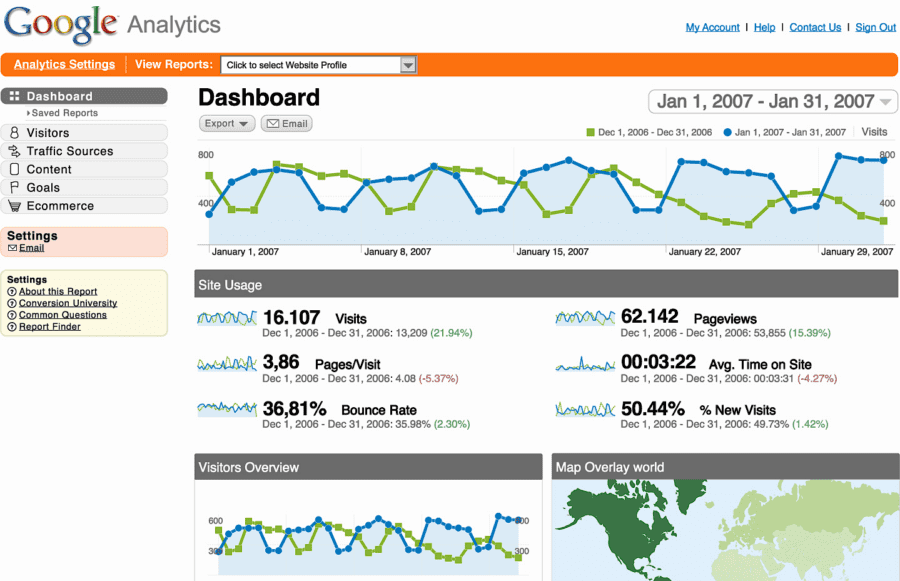
Figure 9: Google Web Analytics
Web analytic metrics like New Visits, Bounce Rate and Time On Site are very relevant metrics if one is trying to measure and improve the usage and navigational effectiveness of the product or solution.
How does the “Test and Validate” step apply to Design Thinking and Machine Learning?
- Design Thinking – monitor usage and navigational metrics to determine the effectiveness of the product or solution. Create a continuous improvement environment where usage and performance feedback can be acted upon quickly to continuously improve the product’s design.
- Machine Learning – exploit the role of “Recommendations” to improve or guide the user experience. Leverage the “wisdom of crowds” to continuously fine-tune and re-tune the supporting analytic models predictive and prescriptive effectiveness.
Design Thinking + Machine Learning = Game Changing Potential
I know that I am probably preaching to the choir here, but I am advising my students and my own kids about the power of integrating Design Thinking and Machine Learning. As an example, my son Max is creating the “Strong by Science” brand by integrating the disciplines of Kinesoleogy with Data Analytics. Heck, he’s even written his first book on the topic (which is probably one more book than he actually read his entire high school career).
But it’s also not too late for us old codgers to also embrace the power of integrating design thinking with machine learning. If you don’t, well, then enjoy being a human battery powering “The Matrix”…
Sentient machines created “The Matrix” to subdue the human population and use the humans as a source of energy.

